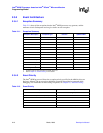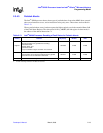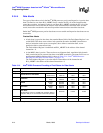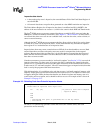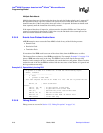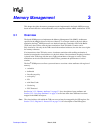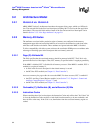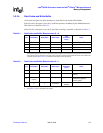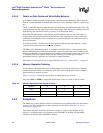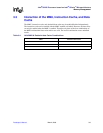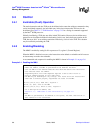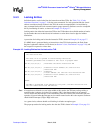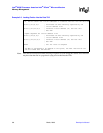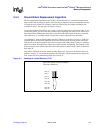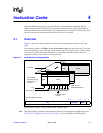
3-4 March, 2003 Developer’s Manual
Intel
®
80200 Processor based on Intel
®
XScale
™
Microarchitecture
Memory Management
3.2.2.5 Details on Data Cache and Write Buffer Behavior
If the MMU is disabled all data accesses are non-cacheable and non-bufferable. This is the same
behavior as when the MMU is enabled, and a data access uses a descriptor with X, C, and B all set
to 0.
The X, C, and B bits determine when the processor should place new data into the Data Cache. The
cache places data into the cache in lines (also called blocks). Thus, the basis for making a decision
about placing new data into the cache is a called a “Line Allocation Policy”.
If the Line Allocation Policy is read-allocate, all load operations that miss the cache request a
32-byte cache line from external memory and allocate it into either the data cache or mini-data
cache (this is assuming the cache is enabled). Store operations that miss the cache do not cause a
line to be allocated.
If read/write-allocate is in effect, load or
store operations that miss the cache requests a 32-byte
cache line from external memory if the cache is enabled.
The other policy determined by the X, C, and B bits is the Write Policy. A write-through policy
instructs the Data Cache to keep external memory coherent by performing stores to both external
memory and the cache. A write-back policy only updates external memory when a line in the cache
is cleaned or needs to be replaced with a new line. Generally, write-back provides higher
performance because it generates less data traffic to external memory.
More details on cache policies may be gleaned from Section 6.2.3, “Cache Policies” on page 6-5.
3.2.2.6 Memory Operation Ordering
A fence memory operation (memop) is one that guarantees all memops issued prior to the fence
executes before any memop issued after the fence. Thus software may issue a fence to impose a
partial ordering on memory accesses.
Table 3-3 on page 3-4 shows the circumstances in which memops act as fences.
Any swap (SWP or SWPB) to a page that would create a fence on a load or store is a fence.
3.2.3 Exceptions
The MMU may generate prefetch aborts for instruction accesses and data aborts for data memory
accesses. The types and priorities of these exceptions are described in Section 2.3.4, “Event
Architecture” on page 2-12.
Data address alignment checking is enabled by setting bit 1 of the Control Register (CP15,
register 1). Alignment faults are still reported even if the MMU is disabled. All other MMU
exceptions are disabled when the MMU is disabled.
Table 3-3. Memory Operations that Impose a Fence
operation X C B
load - 0 -
store101
load or store 0 0 0



